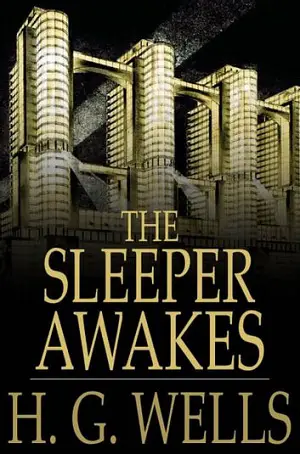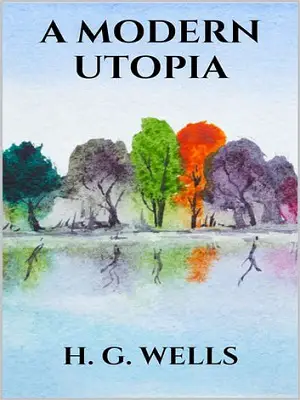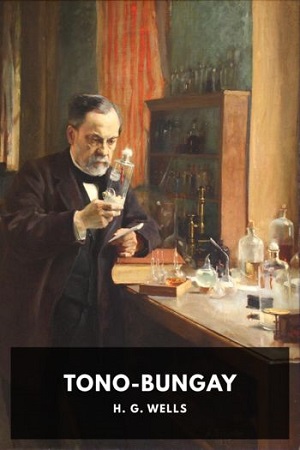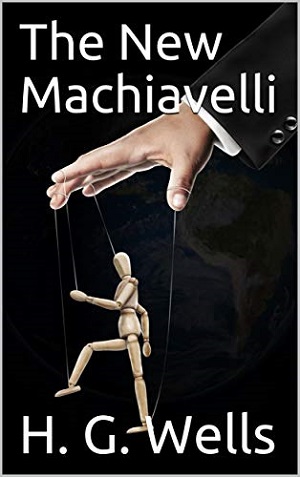Today we bring you a selection of the best books by H.G. Wells in PDF format, but first a little history about this wonderful English writer.
Herbert George Wells was born on September 21, 1866 in Bromley, England. His father played professional cricket and was a shopkeeper for a time. At the age of 7, Wells suffered an accident that left him bedridden for several months. During this time he read many books, including some by Washington Irving and Charles Dickens.
After Wells’ father’s store went bankrupt, his family ran into financial problems. The children were apprenticed to a draper, and his mother went to work on a country house as a lady’s maid. At his mother’s workplace, Wells read the works of Jonathan Swift and some of the important figures of the Enlightenment, such as Voltaire.
As a teenager, Wells went to work as a draper’s helper. He hated the job and eventually quit. As for education, he won a scholarship to the Normal School of Science. During college, he published a short story about time travel called «The Chronic Argonauts», which foreshadowed his future literary success.
In 1895, Wells became an overnight literary sensation with the publication of the novel «The Time Machine».
He worked as a book reviewer for the Saturday Review for several years, during which he promoted the careers of James Joyce and Joseph Conrad. In 1901, Wells published a non-fiction book entitled «Anticipations». This collection of predictions proved remarkably accurate. Wells predicted the rise of large cities and suburbs, economic globalization, and aspects of future military conflicts.
Wells again demonstrated his affinity for predictions. He foresaw the splitting of the atom and the creation of atomic bombs in «The World Set Free» (1914).
In 1920 he published «The Outline of History», perhaps his best-selling work during his lifetime. This three-volume book began with prehistory and continued up to World War I. At this time, Wells ran for Parliament as a Labor Party candidate in 1922 and 1923, without success.
In the 1930s he turned to film. Traveling to Hollywood, he adapted his 1933 novel «The Shape of Things to Come» for the big screen. Around the same time, he worked on the film version of the short story «The Man Who Could Work Miracles».
Wells traveled extensively, visited Russia in 1920, met Vladimir Lenin and Leon Trotsky. He had the opportunity to speak with Joseph Stalin and U.S. President Franklin D. Roosevelt. He also lectured and went on lecture tours, gaining notoriety for his radical social and political views.
In 1891 he married his cousin, Isabel Mary Wells, but the union did not last. Wells married Amy Catherine «Jane» Robbins in 1895, following his divorce. They had two sons together, George Philip and Frank. Wells had numerous affairs.
Wells remained productive until the end of his life. He died on August 13, 1946 in London.
1) Floor Games

It is a book published in 1911 that describes a series of games designed for young children. It is said that Wells had so much fun playing with his children that he decided to write a book to guide other parents in creative play.
Floor Games games could be played indoors and included the following toys: soldiers about two inches tall; large wooden bricks and boards; electric railway rolling stock and rails. For Wells these elements were versatile, as, for example, the boards and planks can be used to create various imaginative geographies, such as cities, or also to realize engineering projects.
Today, Floor Games is considered a guide book on learning through play, as well as non-verbal child psychotherapy. If you are a parent, it will surely inspire you to create enchanting stories with magical worlds and miniature figures.
2) The Discovery of the Future

This is a philosophical lecture originally delivered at the Royal Institution on January 24, 1902, which argues for the possibility of knowing the general (but not the individual) future. It was subsequently published in book form in February 1902.
To begin with, Wells distinguishes two types of mind among people: one oriented to the past (which he describes as passive and submissive) and another that gives importance to what will happen in the future (which for him would be creative, modern and active).
In The Discovery of the Future, the English writer analyzes the reasons for the predominance of minds that give importance to what happened in the past, which he considers to be due to the fact that what we know of the past is evidently greater than what we know of the future. Although, for him, despite the unpredictability of human behavior, the inference that the future is unknowable did not go with modern science.
3) The Time Machine

The Time Machine is a science fiction novel published in 1895 and written in story form. The work is generally credited with popularizing the concept of time travel through the use of a vehicle or device to intentionally and selectively travel forward or backward in time. The term «time machine», coined by Wells, is now almost universally used to refer to such a vehicle or device.
The Time Machine has been adapted into three feature films of the same name, as well as two television versions and many comic book adaptations. It has also indirectly inspired many other works of fiction in many media.
4) The War of the Worlds

The War of the Worlds is a science fiction novel by the English author, first published in 1897 by Pearson's Magazine in the United Kingdom and by Cosmopolitan magazine in the United States.
The novel's first appearance in hardcover was in 1898 by publisher William Heinemann of London. Written between 1895 and 1897, it is one of the first stories to detail a conflict between humanity and an alien race. The novel is the first-person narrative of an unnamed protagonist in Surrey and his younger brother in London when southern England is invaded by Martians. The novel is one of the most talked about works in the science fiction canon.
5) This Misery of Boots

It is a 1907 political treatise advocating socialism, being an expansion of a 1905 essay. It consists of five chapters in which Wells condemns private ownership of land and naturally produced things. He also supports expropriation by the "state" and the administration of land, business, etc.
From the mid-1880s, Wells considered himself a socialist, which was marked by a unique personal bias. As a result, he went on to write numerous essays and four books in favor of and in promotion of this political, social and economic system.
The Misery of Boots is one of such works, where he argues that socialism requires a complete change of the entire system, and that one of the greatest problems it faced was to gain the enthusiasm and loyal cooperation of large masses of people.
6) A Short History of the World

It is an account of human history published in 1922. It is preceded by The Outline of History, and was intended for those readers who wished to study in detail the maps and time diagrams included in The Outline, as well as for those who wanted to refresh their knowledge and concepts about humanity.
A Short History of the World includes the scientific knowledge of the time on the origin and development of the Earth and life, covering topics such as the development of mankind and the Cradle of Civilization. It also contains recent topics for the time, such as the outcome of World War I, the Russian famine of 1921, and the League of Nations of 1922.
If you have not yet decided to read it, this curious fact may convince you: Albert Einstein recommended this book to study history and analyze the progress of civilization.
7) The Wonderful Visit

It is a novel of 1895 that today could be included in the fantasy genre, since it has as its protagonist an angel (based on the Angel of Italian art). It is set in contemporary England and between its lines Wells mocks the customs of Victorian England.
The Wonderful Visit is about the brief visit to the south of England of an angel from the "Land of Dreams", who is at first mistaken for a bird because of its polychromatic plumage, for which he is hunted and wounded in one wing.
Now taken in and under the care of the vicarage, as the days go by the creature becomes more and more dismayed by what he learns of life in Victorian England. And as he becomes increasingly critical of local customs, he ends up being denounced as a socialist.
8) The Island of Dr. Moreau

The Island of Dr. Moreau is an 1896 science fiction novel. The text of the novel is the narrative of Edward Prendick, a castaway rescued by a ship passing by the island where Dr. Moreau, a mad scientist who creates animal hybrids from vivisection, lives.
The novel deals with several philosophical themes, such as pain and cruelty, moral responsibility, human identity, and man's interference with nature. Wells described it as «an exercise in juvenile blasphemy».
The Island of Dr. Moreau is a classic of early science fiction and remains one of Wells' best-known books.
9) The Invisible Man

The Invisible Man is a science fiction novel. Originally serialized in Pearson's Weekly in 1897, it was published as a novel that same year.
The invisible man referred to in the title is Griffin, a scientist who has devoted himself to optical research and who invents a way to change the index of refraction of a body to the index of air so that it neither absorbs or reflects light and thus becomes invisible.
He successfully performs this procedure on himself, but fails in his attempt to reverse it. An enthusiast for random and irresponsible violence, Griffin has become an iconic character in horror fiction.
10) The Wheels of Chance

It is a comic novel about a cycling vacation in August 1895. Although it may seem like a fairly straightforward subject, the truth is that surrounding the cycling craze is a whole series of social events that marked a change in the history of England.
The Wheels of Chance was written when the popularity of bicycles was on the rise, thanks to their availability and affordability. This allowed ordinary people to travel considerable distances quickly and cheaply, giving them a new freedom. This, in turn, brought about several changes in English society (such as the women's emancipation movement) and began to weaken the rigid English class structure.
This novel introduces us to Mr. Hoopdriver, a frustrated, exhausted and underpaid draper's assistant who sets out to cycle along the south coast during his ten-day annual vacation.
11) The Sleeper Awakes

The Sleeper Awakes is a dystopian science fiction novel set first in the year 1897 that introduces us to Graham, a man who due to insomnia takes medication but falls into a coma. Our protagonist sleeps for just over two hundred years, waking up in the year 2100 in a completely transformed London.
He later learns that he has inherited great wealth making him the legal lord and master of most of the world. His money has been placed in a trust and the trustees, the "White Council", have used it to buy up industries and political entities halfway around the world, establishing a vast political and economic world order, the horrors of which will soon be revealed to Graham.
The lower classes led an appalling life, oppressed, manipulated and exploited by the elite. Unskilled workers were paid with food for each day's work, with no job security.
12) Love and Mr Lewisham

It is a 1900 novel set in the 1880s. Some events that unfold in it closely resemble those in Wells' own life: Both he and the protagonist, Mr. Lewisham, were assistant masters in country schools and later began their studies as teacher's apprentices at The Normal School of Science, South Kensington.
While in his third year of studies, Mr. Lewisham is reunited with his first love, Ethel Henderson. The two marry and our protagonist is forced to abandon his plans for a brilliant scientific career, agreeing to move to a ramshackle house in Clapham to care for Ethel and her elderly mother.
Love and Mr. Lewisham is a novel that deals with the relationship between class and emotions, narrating the struggle between love and ambition experienced by its protagonist.
13) The First Men In The Moon

The First Men In The Moon is a scientific romance, originally published in The Strand Magazine from December 1900 to August 1901 and published in hardcover in 1901.
The author called this publication one of his «fantastic stories». The novel tells the story of a journey to the Moon undertaken by the two protagonists: a story-telling businessman, Mr. Bedford, and an eccentric scientist, Mr. Cavor. Bedford and Cavor discover that the Moon is inhabited by a sophisticated extraterrestrial civilization of insect-like creatures called «Selenites».
14) The Sea Lady

The Sea Lady is a novel with a fantastic and romantic narrative mixed with social satire. It was serialized from July to December 1901 and explores serious and mature themes such as sex and the ideal of a world in which moral restrictions are relaxed.
It introduces us to a mermaid who arrives on the south coast of England with the aim of seducing Harry Chatteris, a man she saw some years ago in the South Seas and has become infatuated with. Of course, she does not declare this openly, but pretends that her purpose is to become part of elegant English society.
Although Chatteris is engaged to Miss Adeline Glendower, the mermaid manages to seduce him and he succumbs to her charms.
15) The Food of the Gods and How It Came to Earth

The Food of the Gods and How It Came to Earth is a science fiction novel, first published in 1904. Wells called it «a fantasy about the change of scale in human affairs».
The novel is about a group of scientists who invent a food that accelerates the growth of children and turns them into giants when they become adults.
Book I begins with satirical remarks about the «scientists», and then introduces Mr. Bensington, a research chemist specializing in «the most toxic alkaloids», and Professor Redwood, who after studying reaction times becomes interested in «growth».
16) Kipps

Kipps is a social and humorous novel first published in 1905. It makes a study of class differences through the intellectual, moral and emotional difficulties experienced by the protagonist as he changes social position.
Its protagonist is Arthur Kipps, an illegitimate orphan who is raised by his elderly aunt and uncle. He befriends Sid Pornick, and later falls in love with his younger sister, Ann. However, the Pornicks move away and Kipps becomes interested in Helen Walshingham.
Thanks to a newspaper advertisement, Kipps learns that he has inherited £26,000 and a house from his grandfather. After this his life is turned upside down, but he fails to adapt to his new social class. As fate would have it, he reconnects with Helen Walshingham and they become engaged, but he also meets Sid and Ann…
17) A Modern Utopia

A Modern Utopia is a 1905 novel.
The novel is best known for its idea that a voluntary order of nobility known as the Samurai could effectively govern a «kinetic rather than static» world state to solve «the problem of combining progress with political stability».
In his preface, Wells predicts (incorrectly) that «A Modern Utopia» would be the last in a series of volumes on social problems that began in 1901 with Anticipations.
Unlike those works of nonfiction, this book is presented as a tale narrated by a character known only as the Owner of the Voice, who, Wells warns the reader, «is not to be taken as the Voice of the ostensible author who spawns these pages».
18) In the Days of the Comet

In the Days of the Comet is a 1906 science fiction novel. In it, a green comet causes the nitrogen in the air to become a breathable gas, which causes a great change in human society, where happiness now reigns, there is peace on earth and goodwill to all men.
The protagonist of the story is William Leadford, who quits his job just as an economic recession hits Britain and then finds himself unable to find another position. Frustrated, he blames class injustice for the miserable conditions in which he lives.
At the same time, his emotional life is dominated by his attachment to Nettie Stuart, but she jilts him for another man, so Leadford sets out to kill them both and himself. But just as he is about to do so, the comet enters the Earth's atmosphere and disintegrates, causing a soporific green fog that has an effect on all human beings...
19) The War in the Air

It is a military science fiction novel published in 1908, notable for its prophetic ideas and concepts, such as the use of aircraft for war purposes and the events surrounding World War I.
The protagonist of The War in the Air is Bert Smallways, described as unimpressive and not especially gifted, but far from unintelligent. Throughout the book Bert's moral attitudes go through different stages, at first he tends to glorify war and patriotism. But later, as he is exposed to an increasing series of horrors and bloody scenes, war becomes more and more repugnant to him.
This book describes a war that takes place in the late 1910s, that is, a future history, in which all the great powers of the world became aware of the strategic importance of air power and embarked on an arms race to develop it.
20) Tono-Bungay

Tono-Bungay is a semi-autobiographical realist novel first published in book form in 1909. Its themes include English society and its growing desire to make money and socialism, a subject much discussed by Wells in his other works.
The protagonist and narrator of the novel is George Ponderevo, who devotes 7 years of his life to helping his uncle in the business of producing and selling a patent medicine he (his uncle) has created, Tono-Bungay, despite labeling it a scam.
Time passes and his uncle is about to dominate socially and economically when his business empire collapses. Arguably, his uncle symbolizes the pursuit of money and pleasure, which for Wells was the most important social force in late Victorian and Edwardian England.
21) Ann Veronica

Ann Veronica is a New Woman novel published in 1909, set in Victorian-era London. Among the themes it addresses are female independence and the women's suffrage movement in Britain.
The novel describes the rebellion of Ann Veronica, a biology student at Tredgold Women's College and the youngest of five siblings, against her father's harsh patriarchal regime. After he forbids her to attend a dress ball, in addition to other restrictions that have been imposed on her for no apparent reason, Ann ends up suffering a crisis.
When her father resorts to force to prevent her from attending the ball, she leaves home to live independently in an apartment, triggering other events that lead her to temporarily abandon her studies and devote herself to the cause of women's suffrage. This is the story of a determined woman, who knows what she wants in her life and in her relationships.
22) The History Of Mr. Polly

It is a 1910 comic novel that describes the struggle of its protagonist, -the anti-hero- Mr. Polly, with life. He is a young man described as shy, awkward and aimless, who also lacks confidence in his intellectual faculties and whose emotions are confused.
The story is set in Edwardian England, where the miserable Alfred Polly lives his life hating practically everything around him: his wife, his store, his neighbors, and even himself.
The first chapters of The History of Mr. Polly describe his life up to the age of 20, narrating his marriage to his cousin Miriam and the establishment of his outfitter's shop. Later follows his suicide attempt, which ironically makes him a local hero and earns him the insurance money, which in turn saves him from bankruptcy and leads him to abandon his wife and the store.
23) The Door in the Wall And Other Stories

The Door in the Wall is a short story first published in 1911 in the book «The Door in the Wall and Other Stories». It is about a man, Lionel Wallace, who, in a moment of intimacy with his best friend, tells him a secret that has marked his whole life since he was five years old.
Lionel Wallace's secret is none other than a green door in a white wall, a door he walked through when he was five years old and in which he discovered absolute happiness, in the form of a beautiful garden inhabited by panthers and girls with blond curls and the best playmates a child could wish for.
But everything has an end, and after a period of time that he does not remember, he is returned to real life with a terrible longing for that paradise and although he tries with all his might, both to make himself understood by the adults and to find the green door again, it will be in vain.
24) The New Machiavelli

It could be considered Wells' most autobiographical novel, as its plot was notoriously derived from his affair with the writer Amber Reeves. It was also considered a literary scandal, as it satirized the socialist couple, economists, social reformers and co-founders of the London School of Economics Beatrice and Sidney Webb.
The New Machiavelli protagonist, Richard Remington, is a brilliant Cambridge student who dreams of reforming the nation's society and politics. He enters parliament as a liberal influenced by the socialism of a couple (recognizable as the Webbs), only to switch to the Conservatives.
Time passes and his career is wrecked by his love affair with Isabel Rivers, a brilliant young Oxford graduate, which Remington decides to abandon along with his career, his party and his country when rumors begin to circulate about their relationship.
25) Marriage

Marriage is a novel that narrates the relationship between Marjorie Pope and R.A.G. Trafford, a physicist specializing in crystallography. The two meet when Trafford crashes his plane into the garden of the house where Marjorie and her family were spending the summer.
Once married, they make great efforts to understand and adapt to each other, but to no avail: Trafford abandons scientific research, which makes him feel that he has abandoned his commitment to the truth. Moreover, Marjorie's social ambitions push him further and further away, until he decides to leave his home and his children to reflect in the Labrador wilderness.
His mother convinces him to take Marjorie with him, and they both agree to survive the winter in the wilderness. After many difficulties, they reach a mutually satisfactory agreement and manage to save their marriage, so they decide to return to London.
26) The Passionate Friends: A Novel

The Passionate Friends is a novel whose protagonist and narrator is Stephen Stratton, who maintains a close relationship with Lady Mary, a beautiful woman he has known since childhood and with whom he falls deeply in love at the age of nineteen.
Although she reciprocates his love, marries Justin, a wealthy financier, though she wishes to remain close friends with him. Stephen cannot accept this and breaks off their relationship. Years pass and Stephen begins courting a neighbor, Rachel, but when life finds him again with Lady Mary and they become lovers, he stops.
One day Justin sees Stephen kissing his wife, so he hides her in an Irish castle and convinces Stephen to leave England. While Stephen is in a villa on the Rhine, he meets Rachel again and, after a trip, asks her to become his wife, but by chance of life he meets Mary again at an inn in the Alps.
27) The Wife of Sir Isaac Harman

The Wife of Sir Isaac Harman is a 1914 novel that deals with the desire for greater freedom and the emotional and moral conflicts of its protagonist, Lady Harman, a woman married to Sir Isaac Harman whose marriage is unhappy despite having 4 children and great wealth.
Sir Isaac is a domineering and possessive man whom she meets when she is 17 years old and still a student in a boarding house in Wimbledon. Besides him there is another man who will become involved with Lady Harman, George Brumley, a successful novelist.
Mr. Brumley falls in love with Lady Harman at first sight and his interest in her will lead him to pay her visits and constant invitations to luncheons which she accepts. As the plot progresses, Mr. Brumley's attachment to Lady Harman increases until, after Sir Isaac's death, he seems to win her love at the end of the novel.
28) The World Set Free

The World Set Free is a novel written in 1913 and published in 1914. It has in its narrative the prediction of the most destructive and uncontrollable weapon ever to exist. Thanks to the great technological advances of the time, it was common for Wells to resort to the theme of human mastery of energy and power.
It is quite possible that this novel influenced the development of nuclear weapons: The physicist Leó Szilárd read the book in 1932, and in 1933 he conceived the idea of the neutron chain reaction. Another relevant detail is that it had originally appeared in serialised form under the title A Prophetic Trilogy, it should be noted that here the ending is different.
At the end of the book are the reflections of one of the characters, who affirms that knowledge and power are the essential vocation of humanity, and that there is no limit to either knowledge or power.
29) Bealby

It is a comic novel that tells the story of the escapade of Bealby, a thirteen-year-old boy, from his position as a steward's-room boy at the great house of the Shonts estate. Before his escape, however, he completely upsets the party at which the couple who rent Shonts entertain the Lord Chancellor.
Bealby is taken up by Madeleine Philips, who is the lover of Captain Douglas, a guest of Shonts who has been unjustly blamed for ruining the party. Douglas wishes to capture the boy and thus exonerate himself in the eyes of the Lord Chancellor, but when Bealby finds out he flees, but not before accidentally wrecking the caravan.
He then crosses paths with an amoral vagabond who convinces him to be an accomplice in a robbery that ends up going wrong. Bealby flees but is recognized in Crayminster as a fugitive, manages to escape again but not before the attempt to catch him has wreaked havoc on the town…
30) Boon

It is a work of literary satire from 1915. Among its themes is Wells' debate with Henry James on the nature of literature, both novelists used to be friends and held each other in high esteem, until they fell out in the years before the war.
It should be noted that Wells denied authorship of this book, attributing it to Reginald Bliss, a fictional character created by him, who makes a book out of the literary remains of George Boon, a recently deceased author.
One of the themes addressed in Boon is whether "the mind of humanity" exists; in fact, Wells goes so far as to poke fun at himself by questioning and ridiculing the notion of the collective consciousness of humanity. He is known to have been obsessed with the idea of the "mind of the race," as was Hallery, one of the characters of Boon's unfinished work.
31) The Research Magnificent

The Research Magnificent is a 1915 novel whose text is, implicitly, what a man named White has produced to fulfill the promise he made to his dying friend, William.
William Benham is a man who has dedicated himself to living life nobly and thoroughly, which brings him into conflict with his wife, Amanda, whom despite loving passionately he leaves in England to travel the world in search of wisdom.
Benham dies in the midst of his quest, having been fatally shot while in Johannesburg, but he had earlier come to the tentative conclusion that there are four limitations that prevent people from living nobly: fear; self-indulgence; jealousy; and prejudice (race hatred, the evil side of patriotism, religious and social intolerance, divisive forces, etc.).
32) Mr. Britling Sees It Through

Mr. Britling Sees It Through is a three-part novel published in 1916 about the war experience in southeastern England. It tells the story of Mr. Britling, a carefree writer who is evidently an alter ego of Wells.
The first part, "Matching's Easy At Ease," set in June-July 1914, is devoted to analyzing the character of British society. It introduces Hugh, Mr. Britling's son, and Herr Heinrich, a German student who is forced to leave when war breaks out.
The second part, "Matching's Easy at War," covers August 1914 to October 1915, when Hugh dies at the front. In the third, "The Testament of Matching's Easy", Mr. Britling learns that Herr Heinrich has also died, and writes a letter to his parents. Much of the second and third parts deal with Britain's response to the challenge of war.
33) Anticipations

It is Wells' first non-fiction bestseller, named by himself as the keystone of the main arc of his work. In it Wells made a very accurate prediction, he stated that we were living a reorganization of human society that would alter all dimensions of life, this from the mechanical revolution.
The book is divided into 9 chapters, and among the Anticipations he mentions are: The evolution of the means of terrestrial locomotion, predicting that the new motor vehicles will give rise to motor carriages (trucks, cars) and the motor omnibus (buses).
For the author, by the year 2000, the able productive class will have developed a way of life characterized by a scientific outlook and an unsentimental view of personal relationships, and sexual morality will be largely liberalized. As for languages, he gives only English and Chinese a chance to prosper in the future.
34) First and Last Things

First and Last Things is a philosophical work of 1908 divided into four books (Metaphysics, Of Belief, Of General Conduct and Some Personal Things), in which Wells exposes his beliefs and reflections.
The English author affirms that the mind cannot be trusted uncritically, and that beliefs are not convictions, but positions that are adopted. He criticizes Christianity because he does not believe in the existence of a divine-human mediator, it should be noted that this was written before his religious conversion, in fact in 1917 he made an extensive revision of the book, but later in 1929 he published a new revision in which he returned much of the book to its previous form.
He states that "What am I to do?" is the perpetual question of our existence, and recognizes that the human species remains unawakened as a whole and sunk in the delusion of the separation of the individual and of races and nations. Other themes are love, death and life.
35) God the Invisible King

God the Invisible King is a theological tract published in 1917 in which Wells expounds his religious belief. He states that the God he believes in has nothing to do with magic, providence, punishment, threat or sexual ethics, but is love, courage and youth (i.e., forward- rather than backward-looking).
It defends a modern religion that has no founder, since it rejects any belief related to a creator God. He also rejects the idea that the new religion should be organized in a church, since it is a divinely guided process in men and therefore needs no other guidance or protection, only freedom, free expression and honest declaration.
For him the misconceptions that exist about God are due to mental elaboration. And he considers that belief in God arises from within each person, in other words, there is no way to persuade a person to believe in him.








































